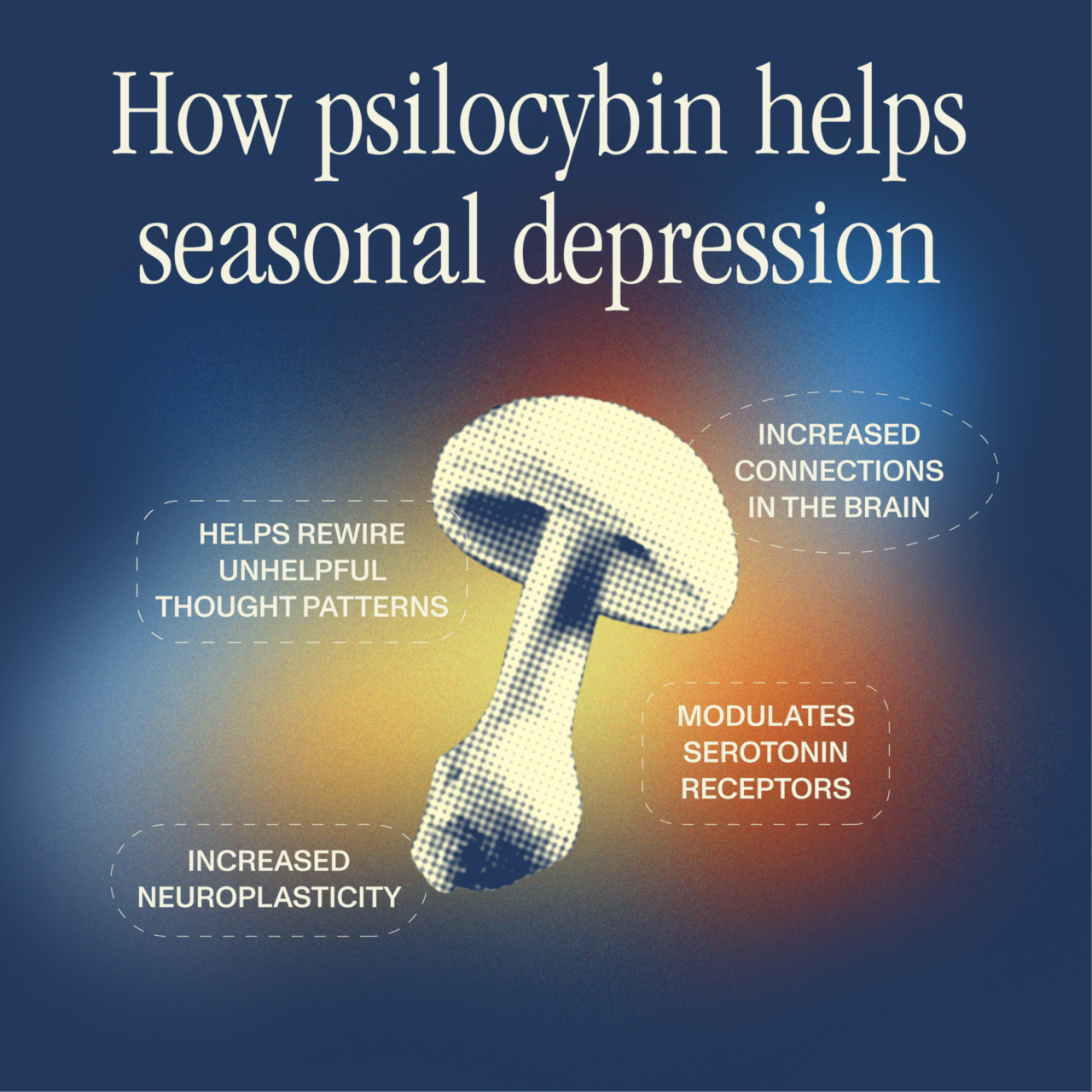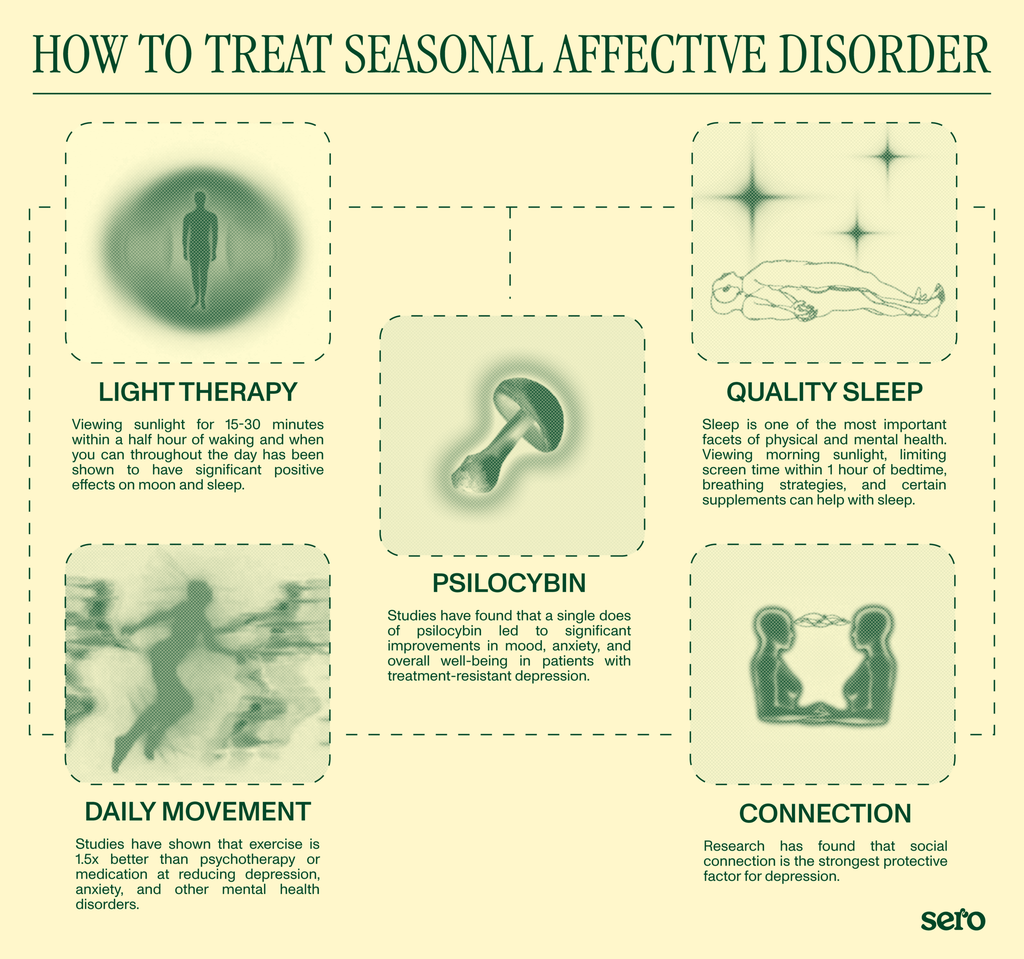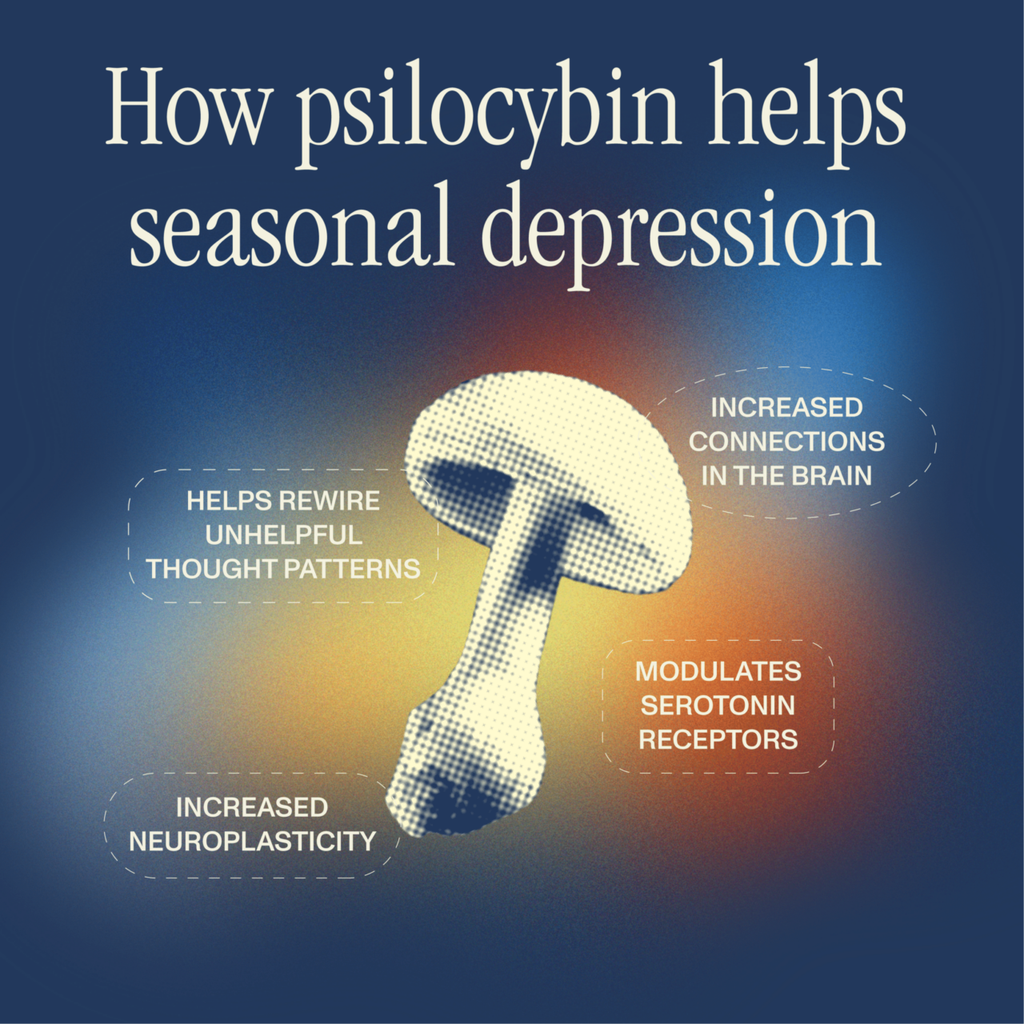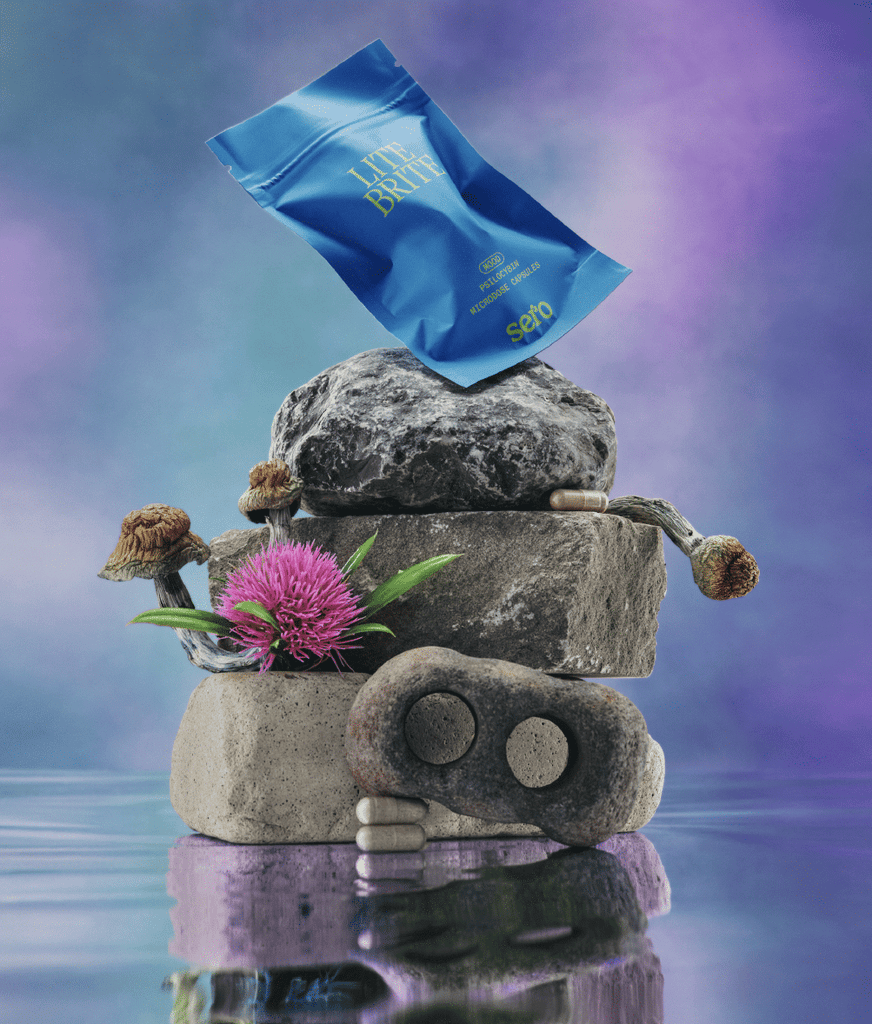Feel Lifted
Looking to microdose and macrodose to improve your mood? Get started with this bundle. .
Free shipping on all orders over $150
Free shipping on all orders over $150
Free shipping on all orders over $150
Free shipping on all orders over $150
Free shipping on all orders over $150
Free shipping on all orders over $150
Free shipping on all orders over $150
Free shipping on all orders over $150
Psilocybin for Seasonal Affective Disorder

Let’s be real – most of us prefer the sun to the clouds and the warmth to the frigid cold. Most of us miss those 9 pm summer sunsets and would prefer not to both leave home and return from work in the dark. For some of us though, that winter gloom just hits harder – significantly affecting mood and energy levels.
Aptly named SAD, Seasonal Affective Disorder (seasonal depression) is a type of depression that occurs seasonally, usually in the fall and winter months when the days are shorter and sunlight is sparse. In today’s blog we’re going to talk about the traditional treatments for SAD plus the power of psilocybin to treat sad. Keep reading for:
What is seasonal affective disorder – symptoms and causes
Seasonal affective disorder vs depression
Traditional treatments for sad
Psilocybin treatment for seasonal depression
Seasonal affective disorder or SAD is a type of recurring major depression that occurs seasonally, usually in late fall or early winter. The Diagnostic and Statistical Manual of Mental Disorders DSM-5 categorizes SAD as depression that starts and ends during a specific season every year (with full recovery the rest of the year) for at least two years, with more seasons of depression than seasons without depression. SAD symptoms tend to come back and improve at about the same times every year.
The definitive cause isn’t known but it’s thought that fall and winter’s shorter days and sparse sunlight hours are the main causes of SAD. Reduced sunlight can disrupt your circadian rhythm (your body’s internal clock), leading to mood changes similar to depression. Additionally, less sunlight can affect your serotonin levels (a neurotransmitter that affects mood) and melatonin (a hormone that helps regulate sleep). The body naturally produces more melatonin when it’s dark, so in the winter months when the days are darker, some people’s bodies make more melatonin, leading to fatigue and lower energy levels – hallmark symptoms of SAD or the “winter blues”.
Additionally, less sunlight can mean less available Vitamin D, the sunshine vitamin, which is also connected to serotonin activity.

The most common type of SAD, also known as winter depression, starts in late fall or early winter and is characterized by depression-like symptoms that can vary greatly from person to person. Some people can experience severe symptoms, while others may have mild symptoms that don’t interfere significantly with their daily life. The main symptoms of SAD are:
Daytime fatigue
Loss of interest in activities you previously enjoyed
Social isolation
Anxiety, irritability, difficulty focusing or concentrating
Feelings of hopelessness
Increased appetite
For those experiencing SAD, symptoms tend to improve when the days get longer and return when the days start getting shorter (typically at the same times each year.) There is also another type of SAD called summer depression which is less common and occurs in the springtime.
Depression: Depression is characterized by persistent feelings of sadness, hopelessness, and loss of interest or pleasure in activities. Symptoms may include changes in appetite, trouble sleeping, fatigue, feelings of worthlessness, and difficulty concentrating.
Seasonal Affective Disorder: SAD or seasonal depression typically occurs during specific seasons, most commonly in fall and winter. Symptoms are similar to depression symptoms and may include oversleeping, overeating, weight gain, social withdrawal, and low energy.
Depression: Depression is not specifically tied to any particular season and can occur at any time of the year.
Seasonal Affective Disorder: SAD symptoms typically follow a seasonal pattern, usually beginning in the fall or winter when daylight hours are shorter. Symptoms tend to improve or disappear during the spring and summer when days lengthen back out.
Depression: The causes of depression aren’t fully understood but can include a combination of genetic, biological, environmental, and psychological factors. Stressful life events, trauma, chronic illness, and neurotransmitter imbalances in the brain can all contribute.
Seasonal Affective Disorder: The exact cause of SAD is not known, but it’s believed to be related to less sunlight exposure and its effects on circadian rhythms and neurotransmitter levels.
The traditional treatments for SAD can include one or a combination of the following therapies:
It makes sense that the antidote to decreased sunlight exposure is to simply spend more time in the sun. Viewing sunlight for 15-30 mins within a half hour of waking and whenever you can throughout the day has been shown to have significant positive effects on mood and sleep.
If it isn’t possible to view sunlight upon waking, a bright artificial light source can be used to simulate the effects of natural sunlight and help regulate circadian rhythms. Light therapy can be done with a bright LED panel or SAD lamp designed specifically for seasonal depression.
Talk therapy with a trained mental health professional can be incredibly helpful to rewire negative thoughts, shift unhelpful patterns, release limiting beliefs, limit and address stressors in your life, and create new behaviours supportive to you being your happiest, healthiest self. Psychotherapy alongside a microdosing protocol can facilitate even more rapid and profound change (more on that below).
For those deficient in Vitamin D during the winter months, Vitamin D supplements may be helpful to replenish the sunshine vitamin missing during those sun-starved winter months.
Antidepressant medications like selective serotonin reuptake inhibitors (SSRIs) are sometimes prescribed to help address symptoms of SAD.
According to Andrew Huberman, renowned Neurobiologist and Professor of Neurobiology & Ophthalmology at Stanford Medicine, there are 6 non-negotiable pillars to mental and physical health: morning sunlight, daily movement, quality nutrition, stress control, healthy relationships, and deep sleep.
Studies have shown that exercise alone is 1.5 times better than psychotherapy or medication at reducing depression, anxiety, and other mental health disorders. Research has also shown that social connection is the strongest protective factor for depression.
Microdosing with psilocybin alongside any of these habits can help solidify those new patterns into lasting habits that don’t take immense amounts of willpower to maintain.
Emerging evidence and many anecdotal reports are recognizing psilocybin (the active compound in magic mushrooms) as a powerful and promising treatment for both traditional depression and seasonal depression. Keep reading for why that is!
Psilocybin is a naturally occurring psychedelic compound found in various species of mushrooms, also know as “magic mushrooms” or “shrooms.” When ingested, psilocybin is metabolized into psilocin, which interacts with serotonin receptors in the brain, leading to alterations in perception, mood, and cognition.
Used for thousands of years in traditional healing ceremonies, psilocybin has gained renewed interest in recent years for its therapeutic effects in treating various mental health conditions including depression, anxiety, SAD, and PTSD.

Psilocybin works on mood disorders like SAD in a few ways. First, it modulates serotonin receptors in the brain, particularly the 5-HT2A receptors, which play a crucial role in regulating mood and emotional processing.
Second, psilocybin fosters connections between different parts of the brain, freeing depressed individuals from persistent patterns of rumination and excessive self-focus, according to a study by scientists at UC San Francisco and Imperial College London.
Third, psilocybin promotes neuroplasticity, which is your brain’s ability to change and adapt following learning or experience. And the most powerful part? This increased neuroplasticity lasts for at least a month after a mushroom ceremony, which helps you solidify new thought patterns, behaviours, and mindsets that will support a healthier mental and emotional state.
By enhancing serotonin neurotransmission, reconnecting regions of the brain, and promoting neuroplasticity, psilocybin can help alleviate depressive symptoms and promote emotional resilience.
At Sero, most of our magic mushrooms products are made with golden teacher mushrooms – a powerful but gentle strain of psilocybin mushrooms known for its thought-provoking and uplifting spiritual experiences.
Our Lite Brite formula is specifically formulated to boost mood and help alleviate anxiety with optimized doses of golden teacher mushrooms, ashwagandha, passionflower and CBD.
There have been countless research studies showing the power of psilocybin for mental health, but the most prominent study conducted by researchers at Johns Hopkins University found that a single dose of psilocybin, administered under controlled conditions, led to significant improvements in mood, anxiety, and overall well-being in patients with treatment-resistant depression. And even more powerfully, their depression severity still remained low one year after the treatment.
These findings suggest that psilocybin has the potential to be a powerful breakthrough treatment for mood disorders, including SAD. By targeting the underlying neurobiological mechanisms of depression and facilitating profound therapeutic experiences, psilocybin has the potential to revolutionize the treatment landscape for mood disorders.
“Psilocybin not only produces significant and immediate effects, it also has a long duration, which suggests that it may be a uniquely useful new treatment for depression. Compared to standard antidepressants, which must be taken for long stretches of time, psilocybin has the potential to enduringly relieve the symptoms of depression with one or two treatments,” says Roland Griffiths, Ph.D., Professor and founding director of the Johns Hopkins Center for Psychedelic and Consciousness Research.

Psychedelic-assisted therapy involves the administration of a moderate dose of psilocybin in conjunction with psychotherapeutic support from a mental health specialist. The psychedelic experience induced by psilocybin may facilitate introspection, emotional processing, and the exploration of underlying psychological issues contributing to depressive symptoms. A trained therapist can then help you integrate that profound experience into your daily life.
If you’d rather wade in slower, psychotherapy is also incredibly powerful alongside a psilocybin microdosing protocol. Microdosing involves ingesting sub-perceptual doses of psilocybin that won’t impact your everyday function but will gradually boost your mood, focus, and creativity levels over time. You may receive insights and nudges which can be either be explored internally or with a therapist who can help find the lessons and meaning in your experience.
Have any questions about psilocybin for mental health? Reach out to us anytime!
Looking to give psilocybin a try? Browse our sustainably harvested magic mushrooms products from microdose capsules to magic mushroom chocolate to mushroom infused tea. Every product we make is handcrafted in Canada with the highest quality, locally sourced ingredients and is tested for quality and consistency.
Read our definitive guides to microdosing and macrodosing for more information on both protocols.